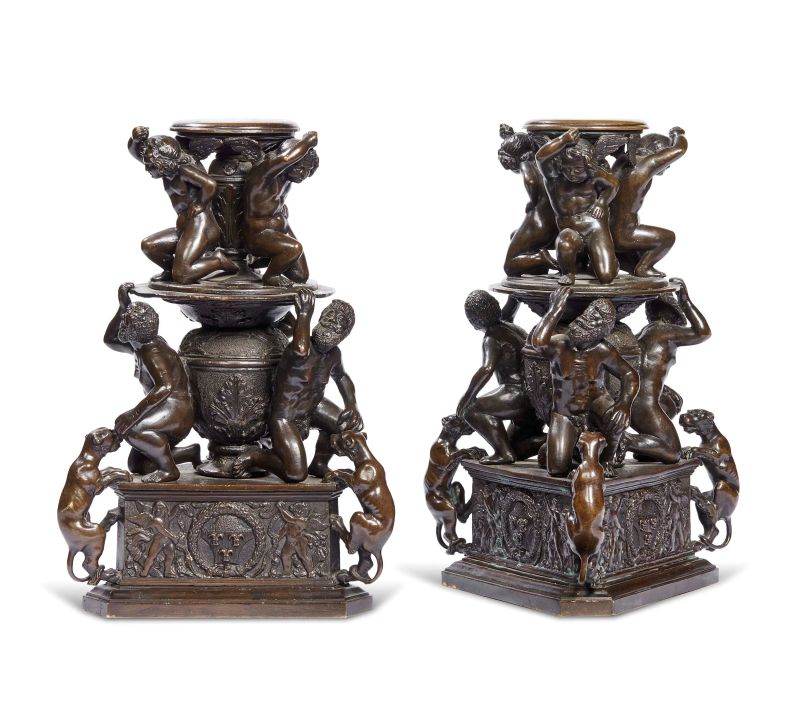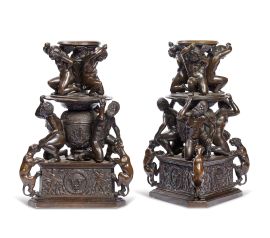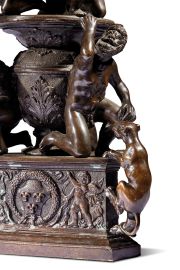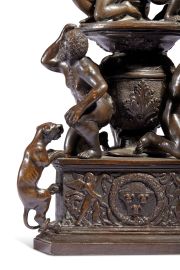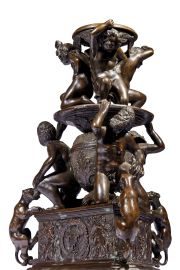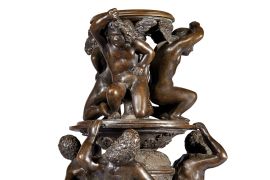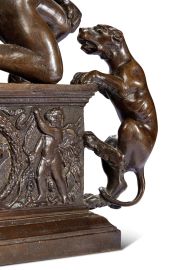PAIR OF CANDLESTICK BASES, SEVERO CALZETTA DA RAVENNA AND WORKSHOP, FIRST HALF 16TH CENTURY
PAIR OF CANDLESTICK BASES, SEVERO CALZETTA DA RAVENNA AND WORKSHOP, FIRST HALF 16TH CENTURY
in patinated bronze on triangular base. The lower part has three rectangular sides each decorated with the Frescobaldi coat of arms in a laurel wreath flanked by a pair of winged putti, embellished at the three corners by full-round climbing lionesses; around the central vase are three kneeling male nudes, with their left arms raised to support the upper level, on which there are three kneeling cupids with bent arms raised above their heads, set around a central baluster surmounted by a round disk, 36 x 25 x 25 cm
Provenance
Florence, Marchesi Frescobaldi (?);
Florence, Collection of Carlo De Carlo;
Brescia, private Collection
Bibliography
Eredi Carlo De Carlo. Parte seconda. Importanti sculture dal Medioevo al Rinascimento, mobili, bronzi, oggetti d’arte, maioliche, rari dipinti di maestri primitivi, Semenzato Casa d’Aste, Florence 2001, lot 59
The success and diffusion of the bronze statuette [bronzetto] in Italy during the Renaissance is a topic that has been widely documented and studied from the many viewpoints that comprise this important cultural and, we can say, “fashion” phenomenon. The earliest small bronzes date from around 1450. The first piece is generally considered the 35 centimeter high statuette of the equestrian monument to Marcus Aurelius which, at the time was near the Basilica of San Giovanni in Laterano in Rome, made by Antonio Averlino called Filarete who gave it to Piero de’ Medici in 1465. The term bronzetto applies to a small statue of not more than 40 centimeters in height, cast in bronze with the lost wax method, depicting a religious or profane subject and conceived as an autonomous piece for a private home. For a better understanding of the history of these small masterpieces, we must mention two essential conditions that developed during those years. On the one hand, there was the Humanists rediscovery of Classical Antiquity and on the other the retrieval of bronze (and casting techniques) as a noble material for making statues. Both are related to Florence in the first half of the fifteenth century and to the name of the period’s greatest sculptor - Donatello.
But Donatello moved to Padua around 1444 and, with him, the city returned to the same vitality triggered by Giotto’s presence one hundred forty years earlier: construction sites reopened, workshops resumed activities and foundries burgeoned. Summoned by the Franciscans to make the altar of Saint Anthony, the greatest undertaking in bronze since Antiquity, Donatello outdid himself in the Equestrian Statue of Gattamelata, completed in 1453, that triggered a great cultural euphoria in Padua. It projected the city’s image as a vital center placing it, among other things, at the center of a trade and patronage network that also reached abroad. Once he had pointed the way, Donatello left room for independent work and research on the part of other masters, starting from Bartolomeo Bellano, beginning the long season of Paduan bronzetto, through which the artists seemed to want to interpret Donatello’s teachings in every possible way. This enormous success and popularity were grounded in the market and in collecting.
Alongside of Bellano was Andrea Briosco called Riccio (1470-1532), a sculptor who found his artistic fulfillment in bronze casting, seeking a synthesis between Mantegna’s classicism and Late Roman statuary. Among other masterpieces, he made the extraordinary Paschal Candelabrum (completed in 1516) for the Basilica del Santo of Padua. For a very long time Riccio was considered the maker of a large part of the pieces produced by one of his “colleagues” - Severo Calzetta da Ravenna (1465/1475 - ante 1538). Severo was quickly forgotten by his contemporaries and later generations only to be “rediscovered” in 1935 by Leo Planiscig who identified his signature on a sea monster in the Frick Collection (New York). Severo, who probably trained with the Lombardos who were active in Ravenna in the 1480s, first appeared in Padua in 1500. Engaged to work on the saint’s tomb in the Basilica del Santo of Padua, he was appointed to produce a marble statue of Saint John the Baptist. During those years he was certainly in contact with the Neapolitan humanist Pomponio Gaurico, who praised him in his treatise De Sculptura, considering him one of the most “complete” artists on the Paduan scene. According to Gaurico, Severo da Ravenna combined all the qualities of statuary: excellent painter and modeler, bronze caster, marble sculptor, engraver, and wood carver. He went on to say that if asked what a sculptor should be like that he would say exactly like Severo” (1). During his years in Padua, Severo developed a series of bronze typologies that met with great success in educated circles and were repeated at length in the large workshop he established upon his return to Ravenna. His son Niccolò carried on the workshop and continued using his father’s models for years. It has been suggested that Severo was the first artist in the Paduan milieu to make figures of satyrs, hydras, chimeras and other monsters mainly for use on practical, or household, objects such as lamps, candelabrums, and inkwells and that he also had a profound influence on Riccio. His figures were characterized by powerful muscles, meticulously finished beards and hair that could be recognized by their “vermicelli” shape, and long, tense fingers. Severo left Padua between 1509 and 1511 to return to his hometown, Ravenna where he remained until his death pursuing a career that probably was not particularly brilliant even though his clients in 1527 included Isabella d’Este, duchess of Mantua who, in the those years was a catalyst for art and culture in Central-Northern Italy. Contemporary scholars unanimously agree that Severo headed the biggest and most productive workshop in the Po Valley which cast a far greater number of bronzes than Riccio. Over the years he collected many ancient models, including some large pieces, on which he made variations thanks to his vivid imagination. Severo was clearly interested in the usefulness of the items made in his workshop and was remarkably skilled in creating complex and at times bizarre pieces in which each part had a specific practical purpose.
The attribution of the items presented here to Severo da Ravenna and his workshop is based on a series of iconographic and stylistic comparisons that leave little room for doubt. This attribution is also confirmed by the importance of the client, borne out by the several repetitions of the Frescobaldi coat of arms (2)(see photo 1). The Frescobaldis were one of the key families in the political, economic and social history of Florence: they were active in trade, banking – i.e. lending, and were among the first of the noble families to farm their vast holdings in the countryside. Furthermore, we know that in addition to his work for Isabella d’Este, Severo’s workshop received commissions from other noble families such as a Siren Candelabra with the arms of the Chigi family and the inkwell with the Spinario (Boy Pulling a Thorn from his Foot) on a table in the portrait of the Major Penitentiary Cardinal Antonio Pucci (3).
The decorative arrangement of our bases is fully matched by a candlestick in the Museo Nazionale del Bargello in Florence (see photo 2), that is widely attributed to Severo da Ravenna and workshop (1510-1540) (4). They share the original three-part composition, the central vase-shaped supports, and above all, the triangular arrangement of the full-round figures that are not only similar to, but actually identical when it comes to the section with the kneeling cupids.
The rectangular plates forming the base, with the centered Frescobaldi coat of arms are directly related to Severo’s oeuvre, as he often used them – especially on caskets such as the one in the Museo Nazionale del Bargello (5), where the model of our plaques was used to make the lid (see photo 3). Since that casket has had a long attribution history – Donatello, Bramante, Desiderio da Firenze, and Riccio – before being ascribed to the artist from Ravenna – we must remember that there are at least thirty-five known versions in addition to “isolated” plaque of the same or only slightly varied design, where the head of Medusa may be replaced by a classical bust, a female bust wearing a tunic, or a coat of arms of the patron or client.
Just above the triangular bases are three kneeling male nudes, figures that are a clear reference to Severo’s famous bronze of Atlas Supporting the Globe of Heaven, of which there is an example in the Frick Collection (New York) (6) as well as a variation comparable to our items in the Metropolitan Museum of Art in New York (7), where Atlas has his left hand on his knee and not on the ground (see photo 4).
Yet another factor confirming the attribution of our bases to Severo comes from what are perhaps the least visible parts, that is the baluster-shaped supports that comprise the core of the entire composition. Here we can make an interesting comparison with the Section of a Candlestick (see photo 5) in the Museo Stefano Bardini, Florence (inv. 904). Even though Stefano Bardini believed it to be a penholder or inkwell, it has correctly been recognized as the lower portion of a candlestick that originally comprised several parts that were cast separately and then joined together, after the model of the piece in the Museo Nazionale del Bargello, consisting of three parts, one atop the other. Even though it is apparently a secondary part, there are several features that connect it with Severo’s definitely attributed works such as the circular base, the stippling effect on the upper part of the surface, and mainly the incised acanthus leaves with sharp tips.
1) Pomponio Gaurico, De Sculptura, Florence 1504, ed. 1999, pp. 130-131.
2) Troncato d’oro e di rosso, a tre rocchi di scacchiere d’argento, 2.1 nel secondo.
3) See J. Warren, “Severo Calzetta detto Severo da Ravenna”, in “Donatello e il suo tempo. Il bronzetto a Padova nel Quattrocento e nel Cinquecento”, Milan 2001, p. 140.
4) Three-part candlestick (Provenance Carrand Collection, Inv. n. 266).
5) Casket (Provenance Carrand Collection, Inv. n. 251).
6) J. Pope-Hennessy, The Frick Collection. Vol. III. Sculpture. Italian, New York 1970, pp. 106-110 (inv. 15.2.24).
7) New York, Metropolitan Museum of Art, Lehman Collection, 1975.1.1399.
References
E. Fahy, Severo Calzetta called, Severo da Ravenna. Late Fifteenth Century-Early Sixteenth Century, The Frick Collection, New York 1978;
R.E. Stone, “Antico and the Development of Bronze Casting in Italy at the End of the Quattrocento”, in Metropolitan Museum Journal, 16, 1982, pp. 94-102;
P. Lorenzelli, A. Veca (ed. by), TRA/E. Teche, pissidi, cofani e forzieri dall’Alto Medioevo al Barocco, Bergamo 1984, pp. 288-295;
P.M. de Winter, “Recent Accessions of Italian Renaissance Decorative Arts. Part I: Incorporating Notes on the Sculptor Severo da Ravenna”, in The Bulletin of The Cleveland Museum of Art, Vol. 73, n. 2, March 1986, pp. 75-138;
G. Toderi, F. Vannel Toderi, Placchette. Secolo XV-XVIII nel Museo Nazionale del Bargello, Florence 1996, pp. 116-117;
C. Avery, Museo Civico Amedeo Lia. Sculture, Bronzetti, Placchette, Medaglie, Milan 1998, pp. 90-113;
J. Warren, “Severo Calzetta detto Severo da Ravenna”, in Donatello e il suo tempo. Il bronzetto a Padova nel Quattrocento e nel Cinquecento, exhibition catalogue, Milan 2001, pp. 131-167;
R.E. Stone, “Severo Calzetta da Ravenna and the Indirectly Cast Bronze”, in The Burlington Magazine”, n. 148, 2006, pp. 810-819;
D. Smith, “I bronzi di Severo da Ravenna: un approccio tecnologico per la cronologia”, in M. Ceriana, V. Avery (ed. by), L’industria artistica del bronzo del Rinascimento a Venezia e nell’Italia settentrionalee, (conference proceedings), Verona 2008, pp. 49-80;
T. Rago, I bronzetti e gli oggetti d’uso in bronzo, cat. Museo Stefano Bardini, Florence;
C. Kryza-Gersch, “The Production of Multiple Small Bronzes in the Italian Renaissance: When, Where and Why”, in Ricche Minere, Anno I, n. 1, March 2014, pp. 20-41;
T. Rago, “Calzettiana tarda. I bronzetti della bottega ravennate di Severo Calzetta del Museo Nazionale del Bargello e del Museo Stefano Bardini a Firenze”, in Proporzioni XI-XII (2010-2011), Florence 2015, pp. 5-37

